HONDA CIVIC COUPE 1999 Owners Manual
Manufacturer: HONDA, Model Year: 1999, Model line: CIVIC COUPE, Model: HONDA CIVIC COUPE 1999Pages: 269, PDF Size: 2.42 MB
Page 251 of 269
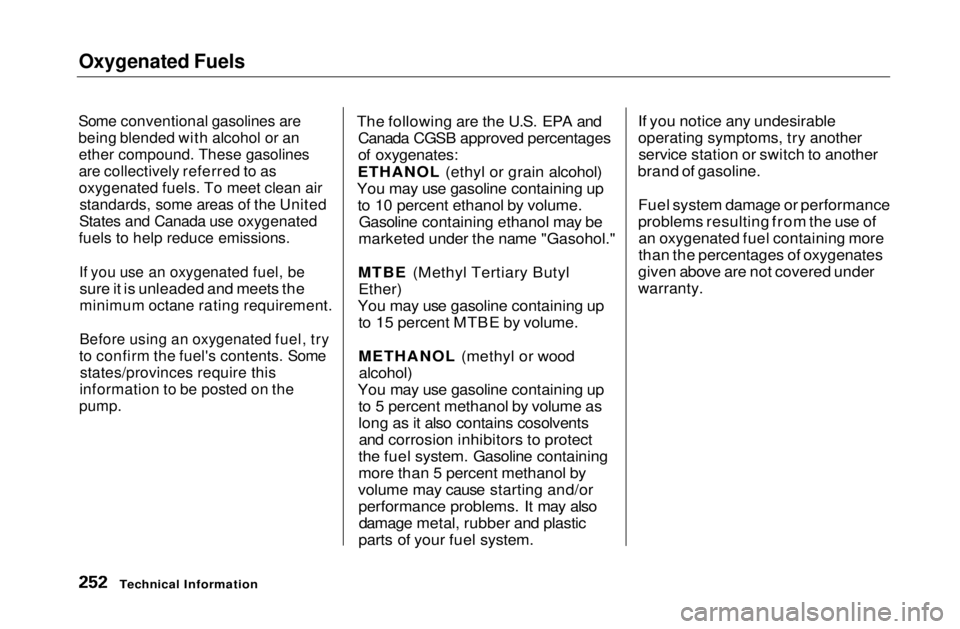
Oxygenated Fuels
Some conventional gasolines are
being blended with alcohol or an
ether compound. These gasolines
are collectively referred to as
oxygenated fuels. To meet clean air
standards, some areas of the United
States and Canada use oxygenated
fuels to help reduce emissions.
If you use an oxygenated fuel, be
sure it is unleaded and meets the
minimum octane rating requirement.
Before using an oxygenated fuel, try
to confirm the fuel's contents. Some
states/provinces require this
information to be posted on the
pump.
The following are the U.S. EPA and
Canada CGSB approved percentages
of oxygenates:
ETHANOL (ethyl or grain alcohol)
You may use gasoline containing up to 10 percent ethanol by volume. Gasoline containing ethanol may be
marketed under the name "Gasohol."
MTBE (Methyl Tertiary Butyl Ether)
You may use gasoline containing up to 15 percent MTBE by volume.
METHANOL (methyl or wood
alcohol)
You may use gasoline containing up to 5 percent methanol by volume as
long as it also contains cosolventsand corrosion inhibitors to protect
the fuel system. Gasoline containing
more than 5 percent methanol by
volume may cause starting and/or performance problems. It may alsodamage metal, rubber and plastic
parts of your fuel system. If you notice any undesirable
operating symptoms, try another
service station or switch to another
brand of gasoline.
Fuel system damage or performance
problems resulting from the use of
an oxygenated fuel containing more
than the percentages of oxygenates
given above are not covered under
warranty.
Technical InformationMain Menu Table of Contents s t
Page 252 of 269
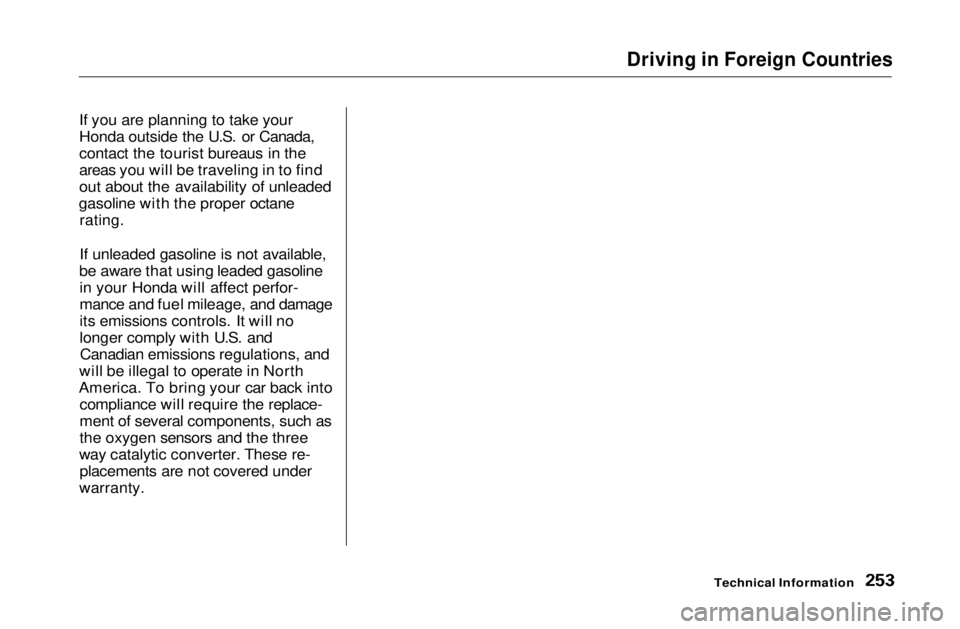
Driving in Foreign Countries
Technical Information
If you are planning to take your
Honda outside the U.S. or Canada,
contact the tourist bureaus in the
areas you will be traveling in to find
out about the availability of unleaded
gasoline with the proper octane
rating.
If unleaded gasoline is not available,
be aware that using leaded gasoline in your Honda will affect perfor-
mance and fuel mileage, and damage
its emissions controls. It will no
longer comply with U.S. andCanadian emissions regulations, and
will be illegal to operate in North
America. To bring your car back into compliance will require the replace-
ment of several components, such as
the oxygen sensors and the three
way catalytic converter. These re- placements are not covered under
warranty.Main Menu Table of Contents s t
Page 253 of 269
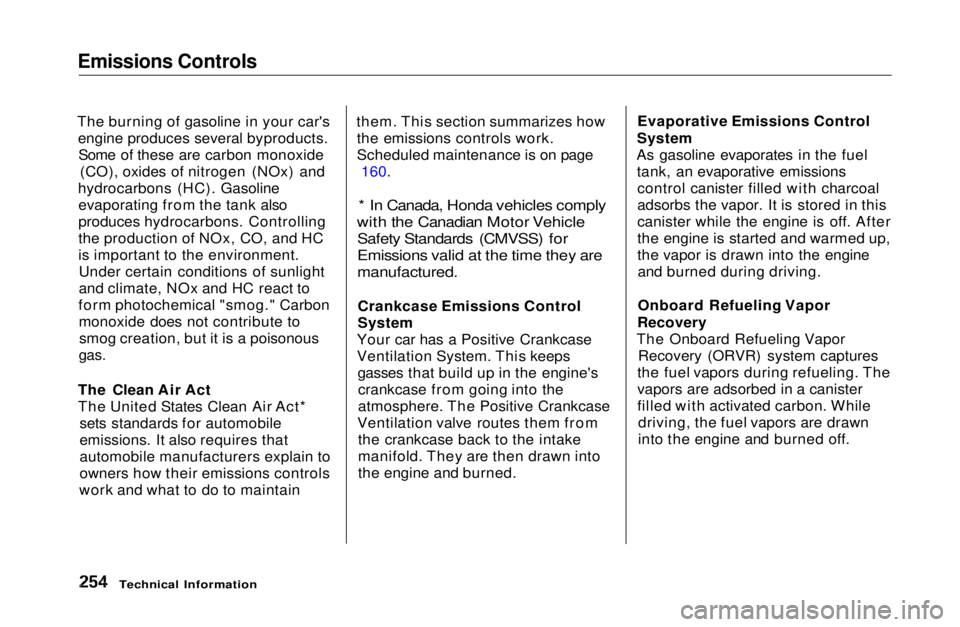
Emissions Controls
The burning of gasoline in your car's engine produces several byproducts.Some of these are carbon monoxide (CO), oxides of nitrogen (NOx) and
hydrocarbons (HC). Gasoline evaporating from the tank also
produces hydrocarbons. Controlling
the production of NOx, CO, and HC
is important to the environment.Under certain conditions of sunlight
and climate, NOx and HC react to
form photochemical "smog." Carbon monoxide does not contribute tosmog creation, but it is a poisonous
gas.
The Clean Air Act
The United States Clean Air Act* sets standards for automobile
emissions. It also requires that
automobile manufacturers explain to
owners how their emissions controls
work and what to do to maintain them. This section summarizes how
the emissions controls work.
Scheduled maintenance is on page 160.
* In Canada, Honda vehicles comply
with the Canadian Motor Vehicle Safety Standards (CMVSS) for
Emissions valid at the time they are
manufactured.
Crankcase Emissions Control
System
Your car has a Positive Crankcase
Ventilation System. This keeps gasses that build up in the engine'scrankcase from going into the
atmosphere. The Positive Crankcase
Ventilation valve routes them from the crankcase back to the intake
manifold. They are then drawn into
the engine and burned. Evaporative Emissions Control
System
As gasoline evaporates in the fuel tank, an evaporative emissionscontrol canister filled with charcoal
adsorbs the vapor. It is stored in this
canister while the engine is off. After
the engine is started and warmed up,
the vapor is drawn into the engineand burned during driving.
Onboard Refueling Vapor
Recovery
The Onboard Refueling Vapor Recovery (ORVR) system captures
the fuel vapors during refueling. The
vapors are adsorbed in a canister
filled with activated carbon. While driving, the fuel vapors are drawn
into the engine and burned off.
Technical InformationMain Menu Table of Contents s t
Page 254 of 269
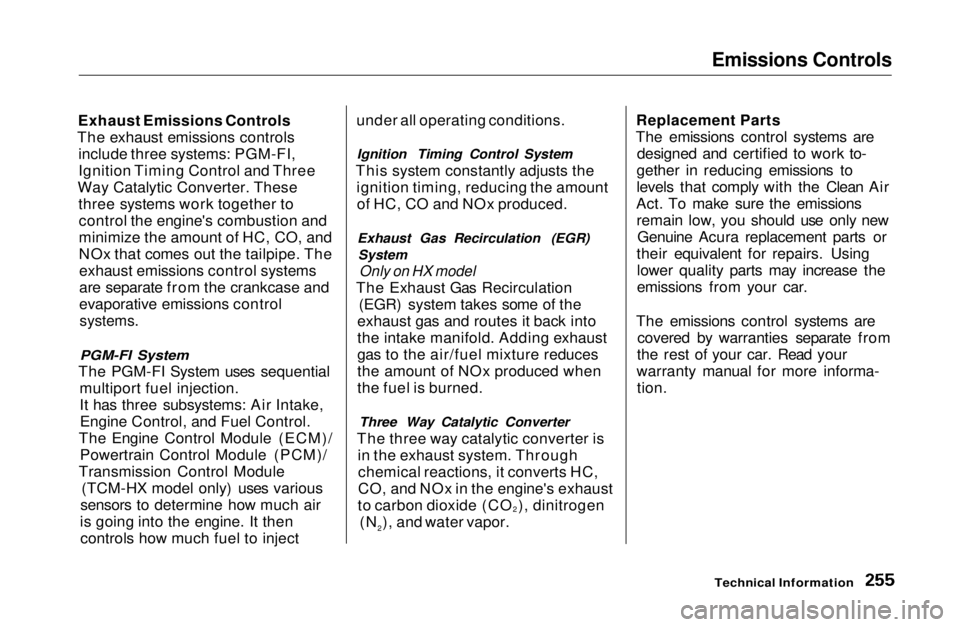
Emissions Controls
Exhaust Emissions Controls
The exhaust emissions controls include three systems: PGM-FI,
Ignition Timing Control and Three
Way Catalytic Converter. These three systems work together tocontrol the engine's combustion and
minimize the amount of HC, CO, and
NOx that comes out the tailpipe. Theexhaust emissions control systems
are separate from the crankcase and
evaporative emissions control
systems.
PGM-FI System
The PGM-FI System uses sequential multiport fuel injection.
It has three subsystems: Air Intake,Engine Control, and Fuel Control.
The Engine Control Module (ECM)/ Powertrain Control Module (PCM)/
Transmission Control Module (TCM-HX model only) uses various
sensors to determine how much air
is going into the engine. It then controls how much fuel to inject under all operating conditions.
Ignition Timing Control System
This system constantly adjusts the ignition timing, reducing the amountof HC, CO and NOx produced.
Exhaust Gas Recirculation (EGR) System
Only on HX model
The Exhaust Gas Recirculation (EGR) system takes some of the
exhaust gas and routes it back into
the intake manifold. Adding exhaust
gas to the air/fuel mixture reduces
the amount of NOx produced when
the fuel is burned.
Three Way Catalytic Converter
The three way catalytic converter is in the exhaust system. Throughchemical reactions, it converts HC,
CO, and NOx in the engine's exhaust
to carbon dioxide (CO 2), dinitrogen
(N2), and water vapor. Replacement Parts
The emissions control systems are designed and certified to work to-
gether in reducing emissions to
levels that comply with the Clean Air
Act. To make sure the emissions remain low, you should use only new Genuine Acura replacement parts or
their equivalent for repairs. Using lower quality parts may increase the
emissions from your car.
The emissions control systems are covered by warranties separate from
the rest of your car. Read your
warranty manual for more informa- tion.
Technical InformationMain Menu Table of Contents s t
Page 255 of 269
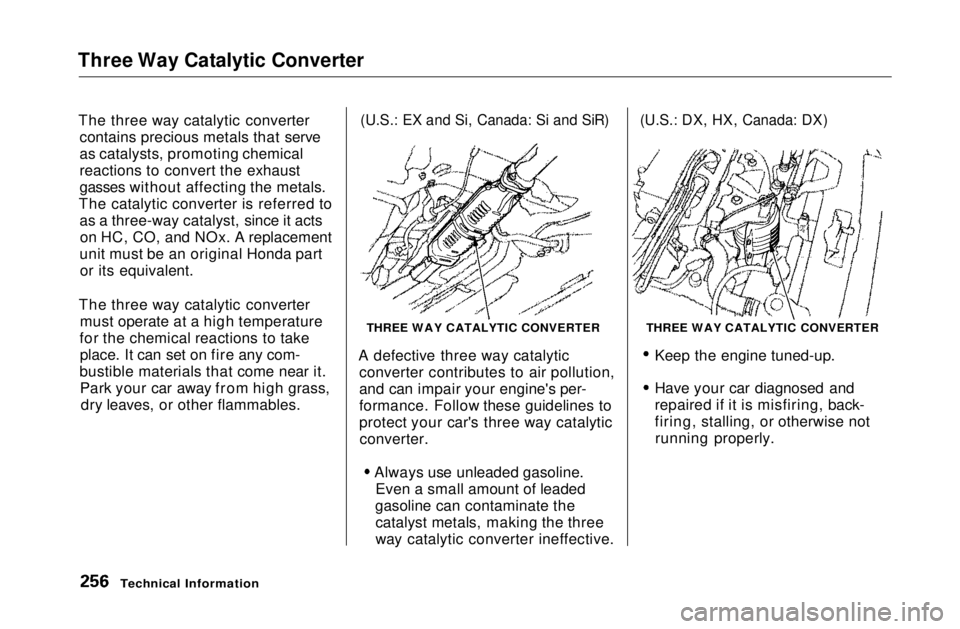
Three Way Catalytic Converter
The three way catalytic converter contains precious metals that serve
as catalysts, promoting chemical
reactions to convert the exhaust
gasses without affecting the metals.
The catalytic converter is referred to as a three-way catalyst, since it actson HC, CO, and NOx. A replacement
unit must be an original Honda part or its equivalent.
The three way catalytic converter must operate at a high temperature
for the chemical reactions to take place. It can set on fire any com-
bustible materials that come near it. Park your car away from high grass, dry leaves, or other flammables.
(U.S.: EX and Si, Canada: Si and SiR)
A defective three way catalytic converter contributes to air pollution,
and can impair your engine's per-
formance. Follow these guidelines to
protect your car's three way catalyticconverter.
Always use unleaded gasoline.Even a small amount of leaded
gasoline can contaminate the catalyst metals, making the three
way catalytic converter ineffective.
(U.S.: DX, HX, Canada: DX)
Keep the engine tuned-up.
Have your car diagnosed and
repaired if it is misfiring, back-
firing, stalling, or otherwise notrunning properly.
Technical Information
THREE WAY CATALYTIC CONVERTER
THREE WAY CATALYTIC CONVERTERMain Menu Table of Contents s t
Page 256 of 269
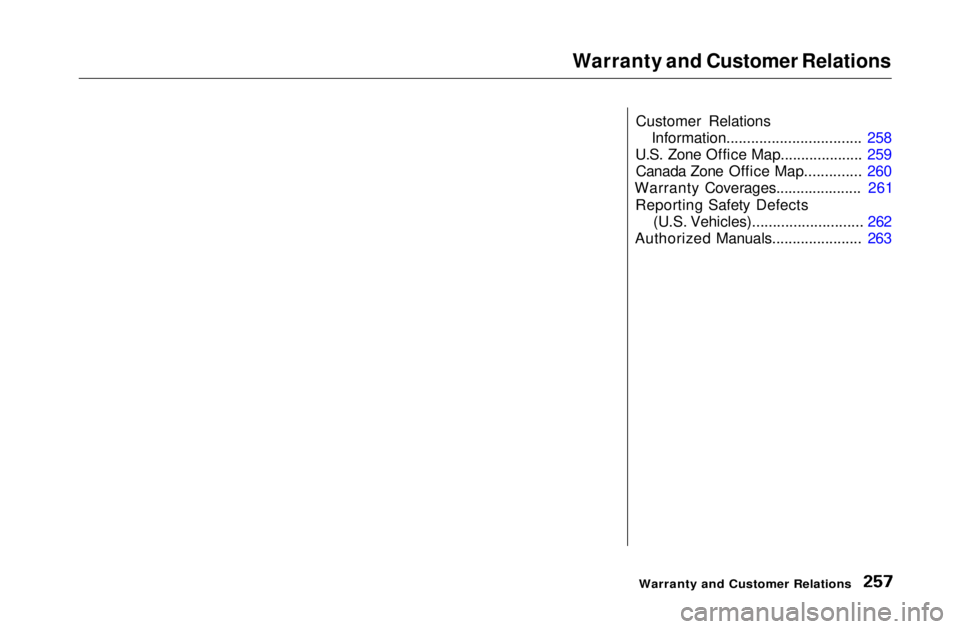
Warranty and Customer Relations
Customer RelationsInformation................................. 258
U.S. Zone Office Map.................... 259 Canada Zone Office Map.............. 260
Warranty Coverages..................... 261
Reporting Safety Defects (U.S. Vehicles)........................... 262
Authorized Manuals...................... 263
Warranty and Customer RelationsMain Menu s t
Page 257 of 269
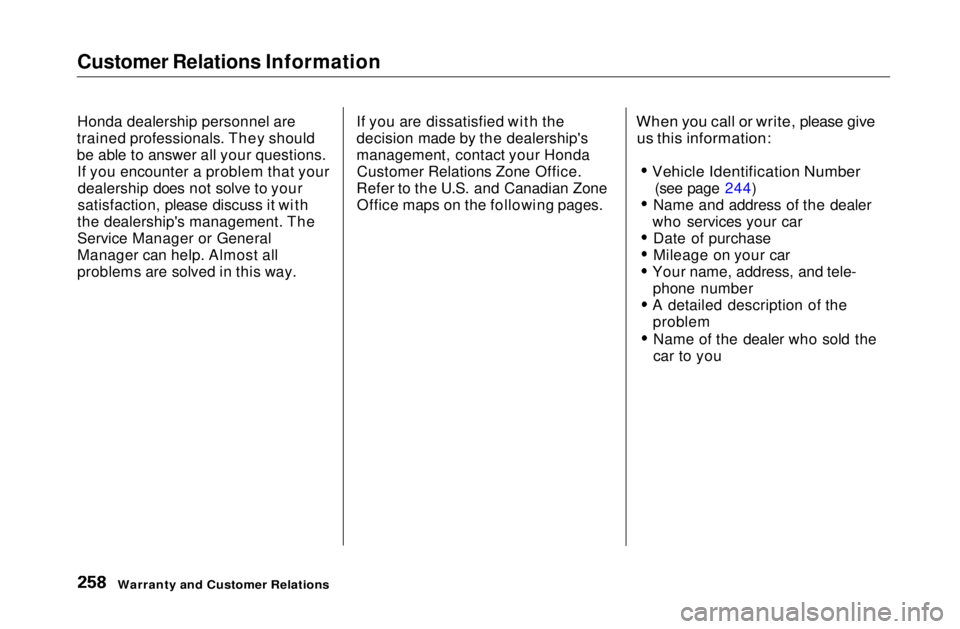
Customer Relations Information
Honda dealership personnel are
trained professionals. They should
be able to answer all your questions. If you encounter a problem that yourdealership does not solve to your
satisfaction, please discuss it with
the dealership's management. The
Service Manager or General
Manager can help. Almost all
problems are solved in this way. If you are dissatisfied with the
decision made by the dealership's
management, contact your Honda
Customer Relations Zone Office.
Refer to the U.S. and Canadian Zone Office maps on the following pages.
When you call or write, please give
us this information:
Vehicle Identification Number
(see page 244)
Name and address of the dealer
who services your car Date of purchase
Mileage on your car
Your name, address, and tele- phone number
A detailed description of the problem
Name of the dealer who sold the
car to you
Warranty and Customer RelationsMain Menu Table of Contents s t
Page 258 of 269
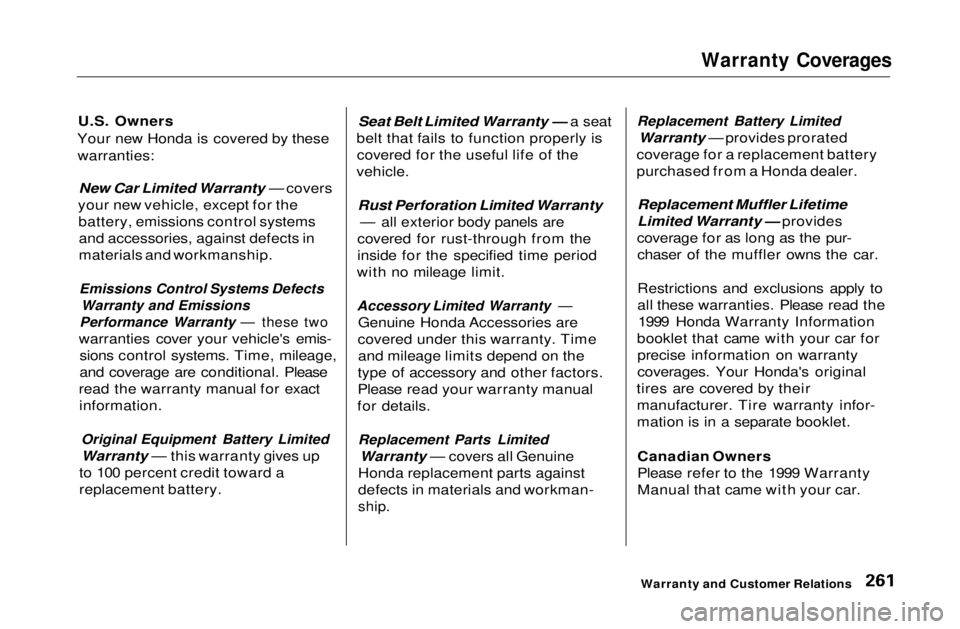
Warranty Coverages
U.S. Owners
Your new Honda is covered by these warranties:
New Car Limited Warranty — covers
your new vehicle, except for the battery, emissions control systemsand accessories, against defects in
materials and workmanship.
Emissions Control Systems Defects Warranty and Emissions
Performance Warranty — these two
warranties cover your vehicle's emis- sions control systems. Time, mileage,
and coverage are conditional. Please
read the warranty manual for exact information.
Original Equipment Battery Limited
Warranty — this warranty gives up
to 100 percent credit toward a
replacement battery. Seat Belt Limited Warranty — a seat
belt that fails to function properly is covered for the useful life of the
vehicle.
Rust Perforation Limited Warranty — all exterior body panels are
covered for rust-through from the
inside for the specified time period
with no mileage limit.
Accessory Limited Warranty —
Genuine Honda Accessories are
covered under this warranty. Time and mileage limits depend on the
type of accessory and other factors.
Please read your warranty manual
for details.
Replacement Parts Limited
Warranty — covers all Genuine
Honda replacement parts against
defects in materials and workman-
ship.
Replacement Battery Limited
Warranty — provides prorated
coverage for a replacement battery
purchased from a Honda dealer.
Replacement Muffler Lifetime
Limited Warranty — provides
coverage for as long as the pur- chaser of the muffler owns the car.
Restrictions and exclusions apply to
all these warranties. Please read the 1999 Honda Warranty Information
booklet that came with your car for precise information on warranty
coverages. Your Honda's original
tires are covered by their manufacturer. Tire warranty infor-
mation is in a separate booklet.
Canadian Owners
Please refer to the 1999 Warranty
Manual that came with your car.
Warranty and Customer RelationsMain Menu Table of Contents s t
Page 259 of 269
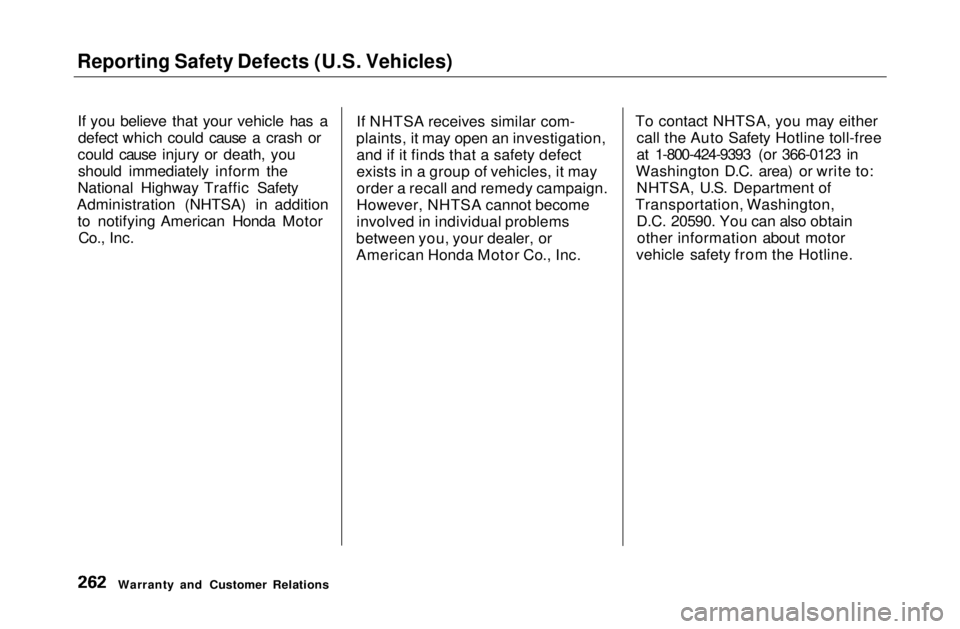
Reporting Safety Defects (U.S. Vehicles)
If you believe that your vehicle has adefect which could cause a crash or
could cause injury or death, you should immediately inform the
National Highway Traffic Safety
Administration (NHTSA) in addition to notifying American Honda MotorCo., Inc. If NHTSA receives similar com-
plaints, it may open an investigation, and if it finds that a safety defect
exists in a group of vehicles, it may
order a recall and remedy campaign.
However, NHTSA cannot become
involved in individual problems
between you, your dealer, or
American Honda Motor Co., Inc. To contact NHTSA, you may either
call the Auto Safety Hotline toll-free
at 1-800-424-9393 (or 366-0123 in
Washington D.C. area) or write to: NHTSA, U.S. Department of
Transportation, Washington, D.C. 20590. You can also obtainother information about motor
vehicle safety from the Hotline.
Warranty and Customer RelationsMain Menu Table of Contents s t
Page 260 of 269
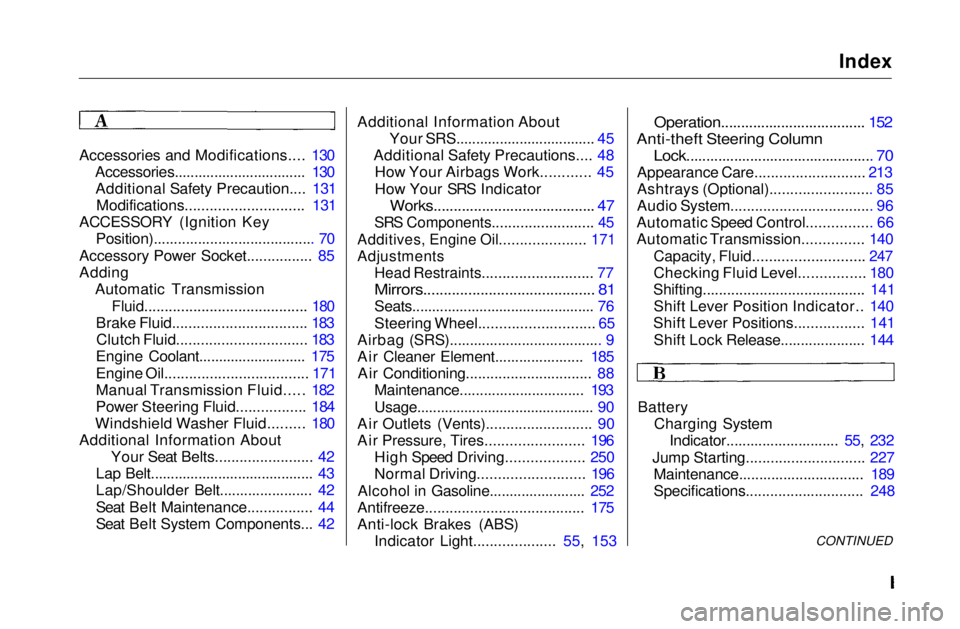
Index
Accessories and Modifications.... 130 Accessories................................. 130Additional Safety Precaution.... 131 Modifications............................. 131
ACCESSORY (Ignition Key Position)........................................ 70
Accessory Power Socket................ 85
Adding Automatic Transmission
Fluid........................................ 180
Brake Fluid................................. 183 Clutch Fluid................................ 183
Engine Coolant........................... 175
Engine Oil................................... 171
Manual Transmission Fluid..... 182
Power Steering Fluid................. 184
Windshield Washer Fluid......... 180
Additional Information About Your Seat Belts........................ 42
Lap Belt......................................... 43
Lap/Shoulder Belt....................... 42
Seat Belt Maintenance................ 44
Seat Belt System Components... 42 Additional Information About
Your SRS................................... 45
Additional Safety Precautions.... 48 How Your Airbags Work............ 45
How Your SRS Indicator
Works........................................ 47
SRS Components......................... 45
Additives, Engine Oil..................... 171
Adjustments
Head Restraints........................... 77
Mirrors.......................................... 81
Seats.............................................. 76
Steering Wheel............................ 65
Airbag (SRS)...................................... 9
Air Cleaner Element...................... 185 Air Conditioning............................... 88 Maintenance............................... 193
Usage............................................. 90
Air Outlets (Vents).......................... 90
Air Pressure, Tires........................ 196 High Speed Driving................... 250
Normal Driving.......................... 196
Alcohol in Gasoline........................ 252
Antifreeze....................................... 175
Anti-lock Brakes (ABS) Indicator Light.................... 55, 153
Operation.................................... 152
Anti-theft Steering Column
Lock............................................... 70
Appearance Care........................... 213
Ashtrays (Optional)......................... 85
Audio System................................... 96
Automatic Speed Control................ 66
Automatic Transmission............... 140
Capacity, Fluid........................... 247
Checking Fluid Level................ 180
Shifting........................................ 141
Shift Lever Position Indicator.. 140
Shift Lever Positions................. 141
Shift Lock Release..................... 144
Battery Charging SystemIndicator............................ 55, 232
Jump Starting............................. 227 Maintenance............................... 189
Specifications............................. 248
CONTINUEDMain Menu s t